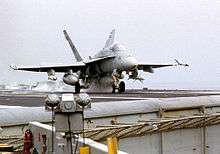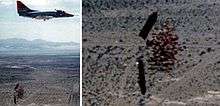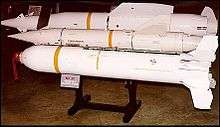CBU-100 Cluster Bomb
The CBU-100 Cluster Bomb (also called the Mk-20 Rockeye II) is an American cluster bomb which is employed primarily in an anti-tank mode. It weighs 222 kg (490 lbs) and carries 247 Mk 118 Mod 1 bomblets.
The anti-tank cluster bomb is an air-launched, conventional free-fall weapon. The Mk 20, CBU-99, and CBU-100 are used against armored vehicles.
Design
When the Mk 20 bomb cluster is released from the aircraft, the arming wires (primary and/or optional arming) are pulled sufficiently to arm the Mk 339 fuze (and recently the FMU-140 fuze) and release the fins. The positive armed fin release arming wire frees the fin release band, and the movable fins snap open by spring-force. Functioning of the fuze initiates the linear shaped charges in the dispenser which cut the dispenser case in half and disperse the bombs/bomblets.
When the Mk 339 Mod 1 primary fuse arming wire is pulled, the fuze will function 1.2 seconds after the arming wire has been extracted. If the pilot selects the option time (4.0 seconds), both the primary and option arming wires must be pulled. If the pilot selects the option time and the primary arming wire is not pulled, the fuze will fail to function and be a dud.
Deployments

The CBUs are delivered to the fleet as completely assembled all-up-rounds. The cargo section of the Rockeye's Mk 7 bomb dispenser is the main structure of the weapon and contains the bombs/bomblets. A nose fairing is attached to the forward end of the cargo section for aerodynamics and fuze installation. It has an observation window for viewing the safe/arm indicator on the installed fuze. The dispenser has two linear-shaped charges secured longitudinally inside the walls. When initiated, these shaped charges cut the dispenser in half, from front to rear, and the bombs/bomblets spread in free-fall trajectories.

To stabilize the weapon after release from the aircraft, a tail cone assembly is attached to the aft end of the cargo section. The tail cone assembly houses four, spring-actuated folding fins. The fins are spring-loaded to the open position and secured in the closed position during ground handling by a fin release-band assembly. The fin release band is secured in the closed position by a safety cotter pin and by the fin release wire. A yellow band around the forward end of the cargo section indicates the explosive content of the weapon.
The Mk 7 Mods 3, 4, and 6 bomb dispensers have the Mk 339 Mod 1 fuze, which provides the pilot with in-flight selection of the fuze function time. The Mk 7 Mod 4 bomb dispenser differs from the Mk 7 Mod 3 by modifying the dispenser and giving interface capabilities with a wider range of military aircraft. The Mk 7 Mod 6 bomb dispenser is the same as the Mk 7 Mod 3 except that the outside of the Mod 6 cargo section is coated with a thermal protective coating and has an additional yellow band around the forward end of the cargo section. The addition of the thermal coating increases the overall weight of the Mod 6 to 505 pounds
Each bomblet weighs 1.32 pounds (600 g) and has a 0.4-pound (180 g) shaped-charge warhead of high explosives, which produces up to 250,000 psi (1.7 GPa) at the point of impact, allowing penetration of approximately 7.5 inches (190 mm) of armor. Rockeye is most efficiently used against area targets requiring penetration to kill.
Fielded in 1968, the Rockeye dispenser is also used in the Gator air-delivered mine system.
During Desert Storm US Marines used the weapon extensively, dropping 15,828 of the 27,987 total Rockeyes against armor, artillery, and personnel targets. The remainder were dropped by Air Force (5,346) and Navy (6,813) aircraft.[1]
According to a test report conducted by the United States Navy's Weapon System Explosives Safety Review Board established in the wake of the 1967 USS Forrestal fire, the cooking off time for a Rockeye CBU is approximately 1 minute and 13 seconds.
References
- "Military-Systems-Munitions-Mk.20" Globalsecurity.org
